The Best Gochujang Substitute (& What NOT to Use)
Gochujang is an umami-packed fermented chilli paste, but it can be tricky to find. But don’t worry, the best gochujang substitute hits all the spots with few ingredients. Read for more alternatives that work and those that don’t.
If you enjoy spicy food, you will love gochujang. The fermented Korean chilli paste is salty, sweet, smoky and spicy. But, it can be tricky to find in small grocery stores.
Luckily this gochujang substitute hits that sweet and savoury spot!
See the recipe card for the best homemade gochujang substitute or try one of the other great alternatives from the list. And don’t forget the section on what NOT to use as a gochujang substitute. I’ve got you covered!
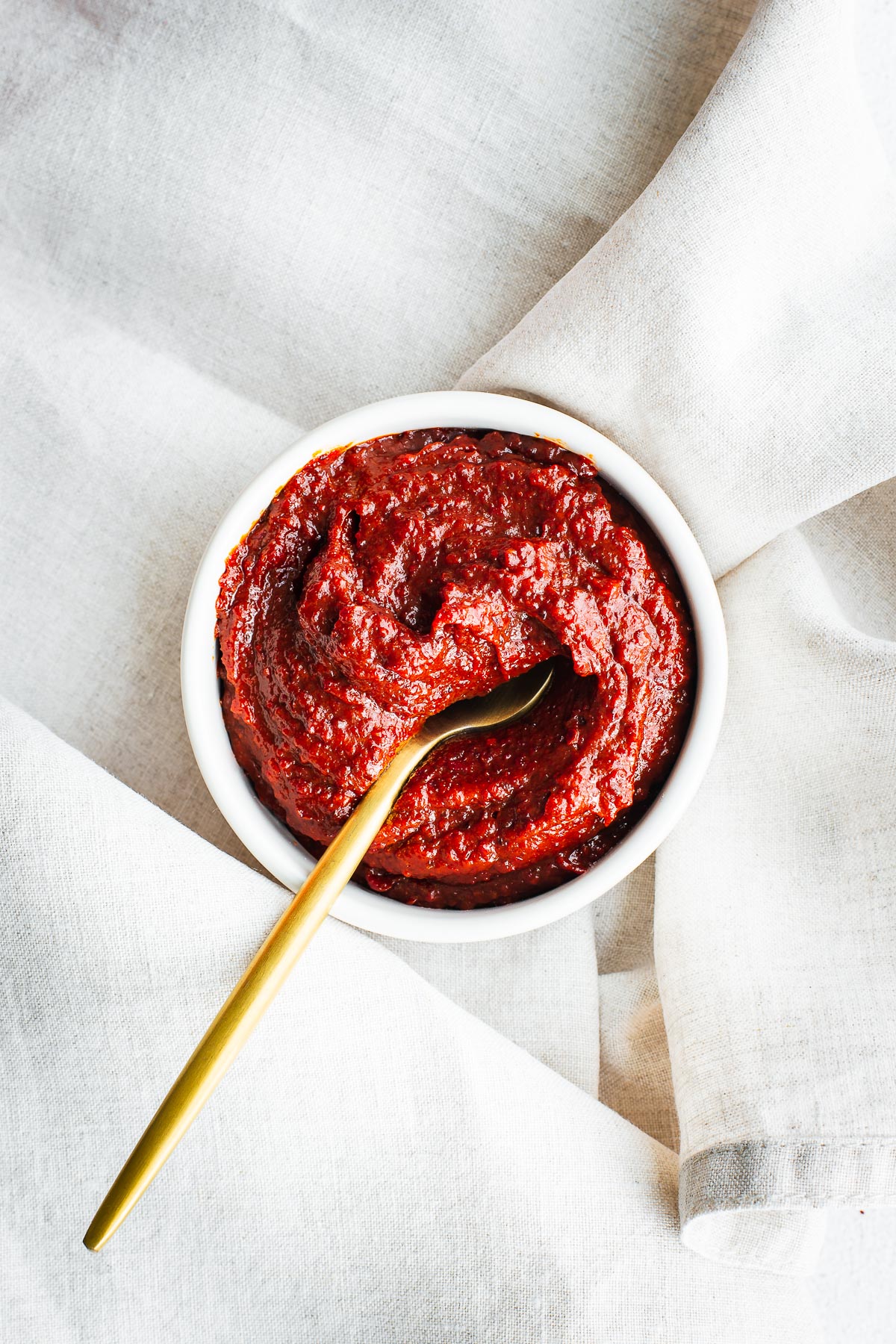
What is gochujang?
Gochujang (also gochu-jang, red chilli paste or hot pepper paste) is a spicy Korean fermented paste. It has a dark, red colour with an intensely savoury, sweet, spicy, and almost smoky taste. And that funky flavour of gochujang embodies Korean cuisine.
The sweetness is from the starch of cooked glutinous rice, cultured with enzymes during fermentation. Gochugaru, made from dried Korean chilli peppers, also contributes to the sweet taste.
Gochujang is available in different levels of spiciness: Mild, Slight Hot, Medium Hot, Very Hot and Extreme Hot. I like mine medium hot. And it’s pretty hot when tasted on its own. But it adds the perfect kick to cooked dishes.
Gochujang ingredients
The main ingredients of traditional gochujang are:
- Korean red chilli powder (called gochugaru, Korean chili powder or flakes),
- glutinous rice powder,
- barley malt powder (yeotgireum),
- powdered fermented soybeans (meju),
- and salt.
Sometimes a small amount of sweetener (like sugar, syrup, or honey) is added.
Glutinous rice (chapssal) or short-grain rice (mepssal) can replace glutinous rice powder. And some special variations of gochujang use whole wheat kernels, jujubes (red dates), pumpkin, or sweet potato.
Commercial gochujang ingredients can also include wheat flour, brown rice, corn syrup or tapioca syrup, wheat, cooking rice wine, defatted soybean powder, koji, alcohol (as preservative), garlic and onion.
Therefore, allergens in commercial gochujang may include wheat and soybean. So, most gochujang sold in grocery stores are not gluten-free.
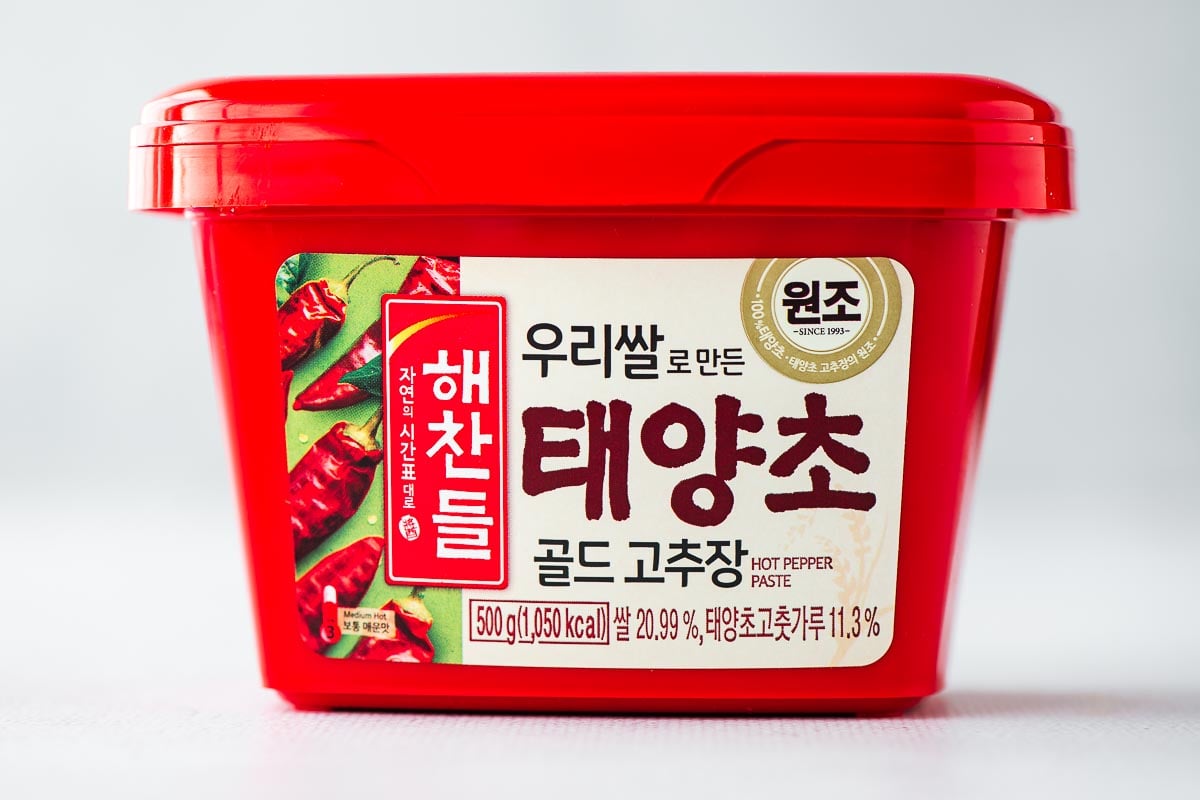
How is gochujang made traditionally?
Traditional gochujang is fermented outside in an earthenware container (jangdok, hangari, or onggi). However, thanks to the commercial production of gochujang (since the early 1970s), most Koreans now buy gochujang at grocery stores or markets.
Homemade gochujang is a surprisingly easy fermentation project. But, you need to track down the ingredients and find a suitable container for fermentation. Hyosun from Korean Babsang has a detailed post on how to make gochujang.
The fermentation needs at least two months, but longer fermentation delivers a more intense umami flavour.
Gochujang in Korean cuisine
Gochujang is not a ready-to-use Korean condiment. But, it forms the base of many dishes and sauces in Korean food. It flavours stews (jjigae) and marinates meat. And adds a spicy kick to naengmyeon (a Korean noodle dish), bibimbap (Korean rice bowls), and spicy tteokbokki (simmered rice cake).
Dubu jorim is a braised tofu dish that traditionally uses gochugaru chilli flakes. But I love to add gochujang to the spicy braising liquid. See the Gochujang tofu (spicy Korean braised tofu) for more information.
Or try a delicious Korean broccoli side dish. Add a teaspoon of gochujang (or gochujang substitute) to this Korean sesame broccoli salad.
Gochujang also forms the base of other condiments. Cogochujang contains gochujang with vinegar and other seasonings, such as sugar and sesame seeds. Ssamjang is a mix of gochujang and doenjang with more flavourings like chopped onions.
The chilli pepper paste makes dishes spicier (depending on the spiciness of the gochujang), but it also adds a sweet, smoky savouriness.
The best substitutes for gochujang
Gochujang is deeply savoury, slightly sweet and a bit funky. The first taste of gochujang is very salty, followed by a complex sweet, fermented flavour before the spicy chilli pepper kicks in.
The spicy paste enhances the flavour of Korean dishes and sauces. It is not a standalone condiment. So, when you taste gochujang on its own, it should be spicier and saltier than you expect.
For use in Korean recipes, there is no perfect standalone substitute for gochujang. So, we get creative to achieve the perfect blend of spicy, sweet, fermented umami.
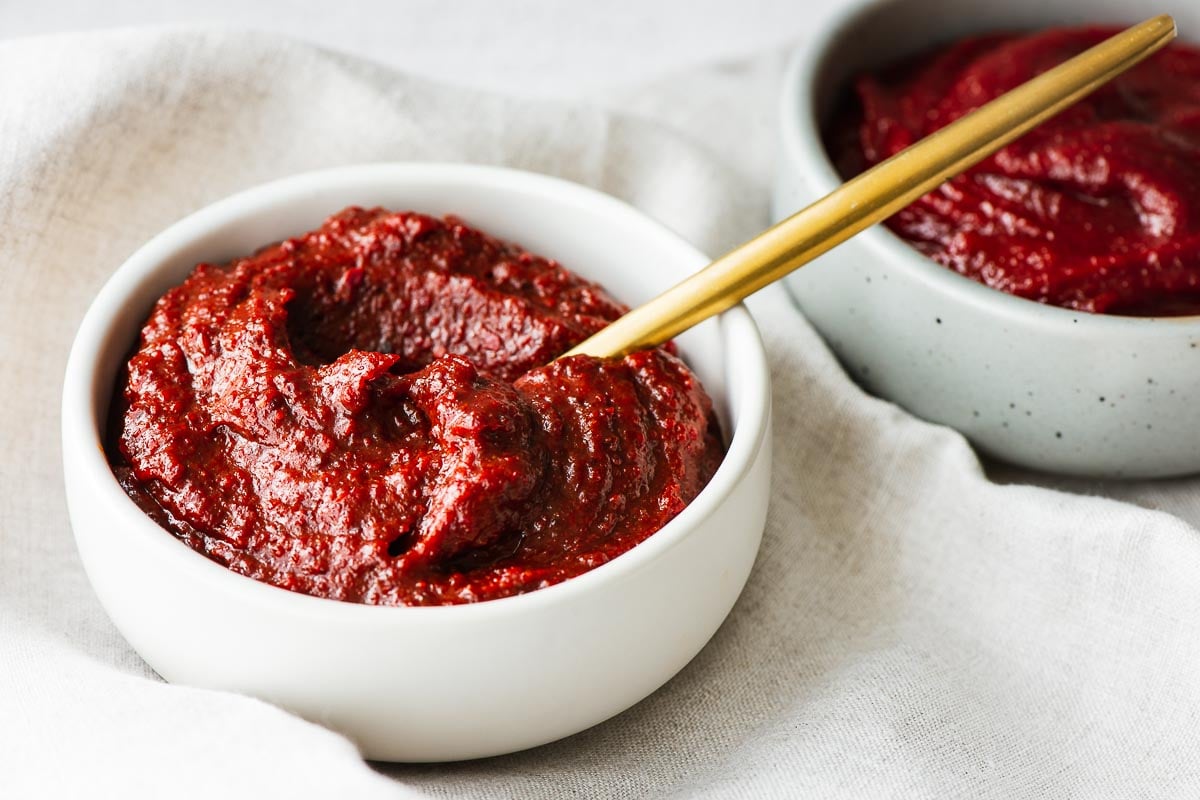
1. The best homemade gochujang substitute
Gochujang has a complex, savoury flavour with a touch of sweetness and a spicy kick. To recreate these flavours, we rely on fermented soybean paste, spicy gochugaru, smoky maple and a few more flavour boosters.
Homemade gochujang substitute ingredients:
- Miso paste: Gochujang contains powdered fermented soybeans, called meju. And miso paste is a Japanese fermented soybean paste, so it has the right paste-like texture and flavour for a gochujang substitute. You can also use doenjang, the Korean fermented bean paste. But if you struggle to find gochujang, doenjang will be even trickier.
- Gochugaru: The Korean chilli powder that gives gochujang its distinctive spicy taste. The texture of gochugaru can vary from a fine powder to coarser flakes. Fine gochugaru powder is best for gochujang. But, if you have flakes, blitz them in a spice grinder before you start. While gochugaru has a distinctive spicy yet sweet flavour, you can substitute other chilli powders for gochugaru.
- Maple syrup: This sweetens the paste and adds that slightly smoky flavour we love. But you can use another sweetener like brown rice syrup or honey.
- Soy sauce: Gochujang is very salty and deeply savoury. Soy sauce adds the salty umami taste, but too much will reduce the vibrant red colour. Light soy sauce is best to preserve the colour, but I also use all-purpose soy sauce. You can omit the soy sauce and add salt (with water) to taste.
- Rice vinegar: While gochujang is not as sour as many fermented products, it does have a slightly acidic sweetness. The mild and sweet acidity of rice vinegar is perfect for this. But you can use another vinegar, like apple cider vinegar, or completely omit it.
- Onion powder: This versatile, deeply savoury powder boosts that required umami punch. You can also use garlic powder or a clove of fresh garlic.
Related Post: The Best Gochugaru Substitute (for Every Use Case)

2. Ssamjang (the best shop-bought substitute)
Ssamjang is a thick, spicy paste with gochujang in it, making it a great alternative. It also contains fermented soybeans (doenjang), sesame oil, onion, garlic, green onions and brown sugar.
In a pinch, ssamjang can be a good substitute for gochujang. But it works even better if you add a splash of maple syrup and chilli powder. Add fine cayenne pepper to taste if you don’t have gochugaru.
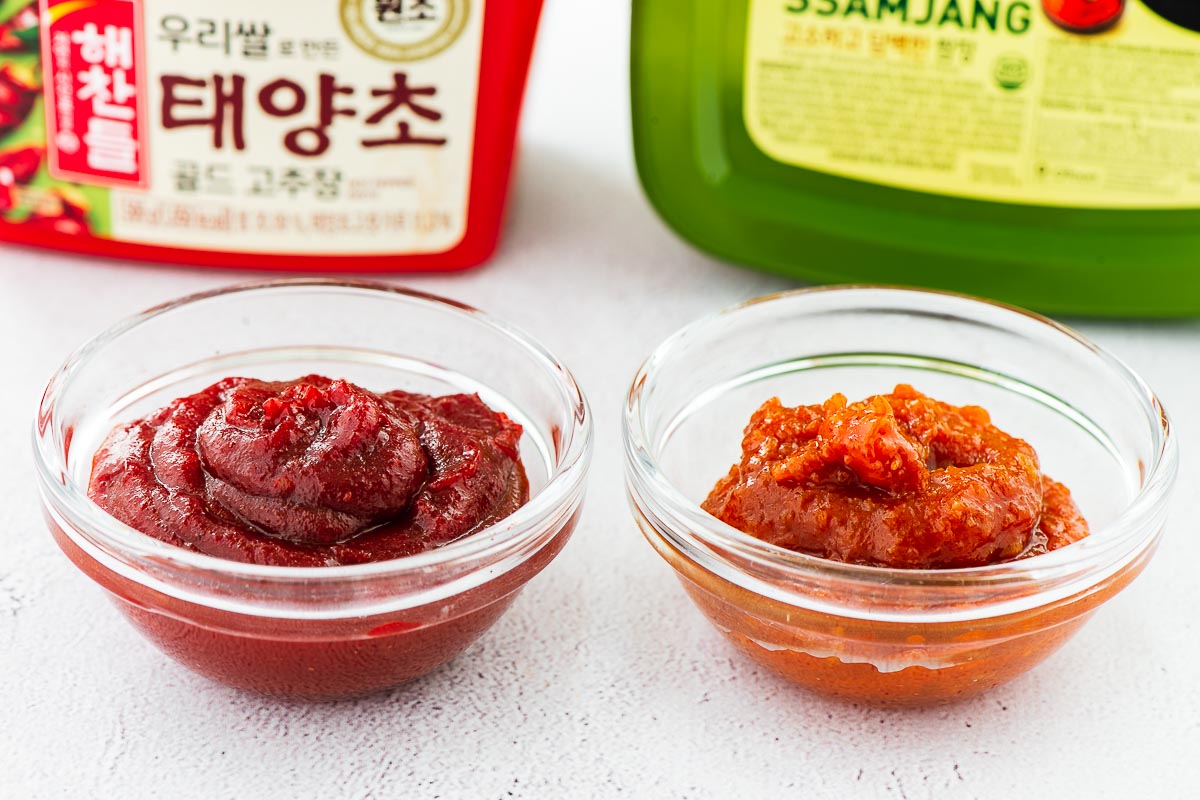
3. Doenjang + Gochugaru
Doenjang is a fermented bean paste, similar to the better-known Japanese miso paste. Though Japanese miso is fungus fermented and doenjang with a bacterial culture.
The best gochujang substitute is sweet, salty, smoky and umami-packed. So, a good alternative is doenjang, gochugaru (or hot pepper powder) and a pinch of sugar.
Use roughly the same volume of chilli powder to doenjang and thin it with water as needed. If you have coarse gochugaru flakes (as in the picture below), grind it into powder before mixing it with the doenjang.
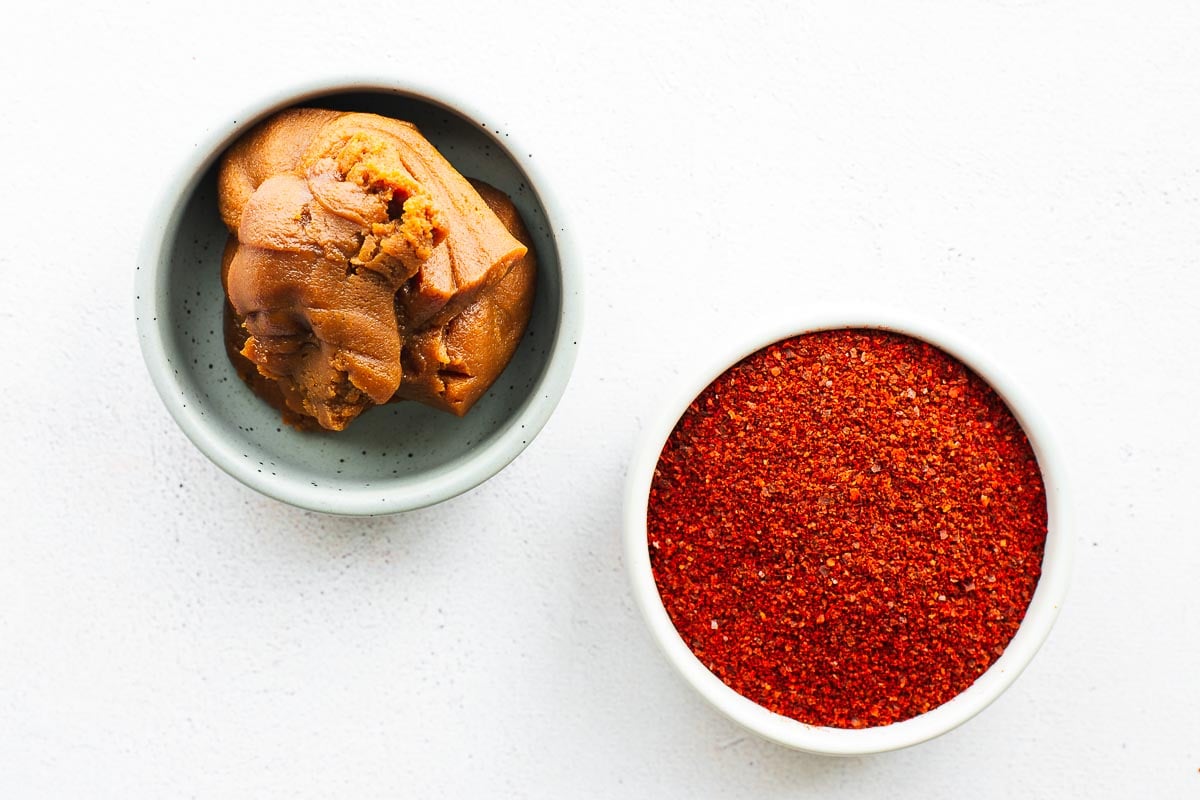
4. Miso paste + cayenne pepper
Japanese miso paste varies in flavour. It can be fruity (the koji in miso has an almost apricot-like taste) or intensely savoury. And, like doenjang, it is a great gochujang substitute when adjusted somewhat.
If your miso paste has a very thick texture (like in the picture above), thin it with a splash of water. Then mix in the cayenne powder until you reach your preferred spice level. Because the savouriness of miso paste varies, you may need to add salt or soy sauce. Add a dash of sugar (or maple syrup) for that touch of sweetness.
5. Sambal oelek (ulek) + maple syrup
There are more than 200 varieties of sambal in Indonesia. The intensity ranges from mild to very hot. Some sambal ingredients include shallot, garlic, lemon or lime juice, kaffir lime leaves, garlic, terasi (a pungent shrimp paste), candlenuts and palm sugar.
So, not all sambals make a good substitute for gochujang. Sambal oelek is a raw chilli paste with vinegar and lemon juice. It is the simplest in flavour but lacks the fermented complexity of gochujang and the sweet, smoky flavour.
To use sambal oelek as a substitute for gochujang, add one tablespoon of maple syrup for every ¼ cup of sambal. To get even closer to gochujang, add a tablespoon of miso paste.
6. Sriracha sauce
Sriracha is a sweet and spicy fermented hot sauce from Thailand. It contains chilli, sugar, salt, garlic and vinegar.
It is a great flavour match for gochujang, but it is a much thinner sauce, not paste-like.
Use it as a direct substitute. Or, for a better gochujang-like texture, mix extra hot sriracha with miso paste.
7. Tomato paste
Originally I had tomato paste in the next section. Products you should NOT use as a gochujang substitute. Gochujang is a red paste, and so is tomato paste. But that is where the similarities end.
To turn tomato paste into its best version of a gochujang substitute, you should add miso paste (for fermented flavour, maple syrup and chillies. But then you can omit the tomato paste. Because miso paste mixed with maple syrup and chillies is already an excellent flavour match for gochujang. See where I’m going with this?
But, miso paste is fermented soybeans and grains, and the grains can be rice or wheat. Therefore, not all miso paste is gluten-free.
You can consider tomato paste if you require a gluten-free alternative to gochujang (and can’t find gluten-free miso). Mix a quarter cup of tomato paste with a tablespoon each of tamari and maple syrup. Add cayenne pepper powder and salt to taste.
Don’t use these gochujang substitutes
Some of the recommended substitutes for gochujang really don’t cut it. While they are delicious pastes I love to use in cooking, the flavour profile does not match that unique Korean flavour of gochujang.
Harissa paste
Don’t get me wrong. I adore harissa paste and regularly make my own rose harissa. I’m obsessed with the fiery, fragrant, naturally sweet red pepper paste. But the fragrance is of cumin, caraway, fennel and other typical Maghrebi ingredients – ingredients that are not common in Korean cooking.
Read more about harissa and how to make rose harissa at home.
Thai chilli paste
Like harissa paste, this chilli paste is delicious, an absolute flavour bomb. It is beautifully funky and fragrant, thanks to dried shrimp and shrimp paste making up about 20% of the paste. But, this fishy flavour is unfortunately not such a good match for the sweet and smoky gochujang flavour.
One exception is when you make a seafood-based Korean dish that requires gochujang, like Ojingeo Bokkeum where squid is stir-fried in a gochujang-based sauce. Then Thai chilli paste can be a delicious alternative, even though you will end up with more Thai than Korean flavour.
While you shouldn’t use Thai chilli paste as a substitute for gochujang, you can use gochujang as a substitute for Thai chilli paste. Just add tamarind and shrimp paste for a quick-and-easy Thai chilli paste substitute.
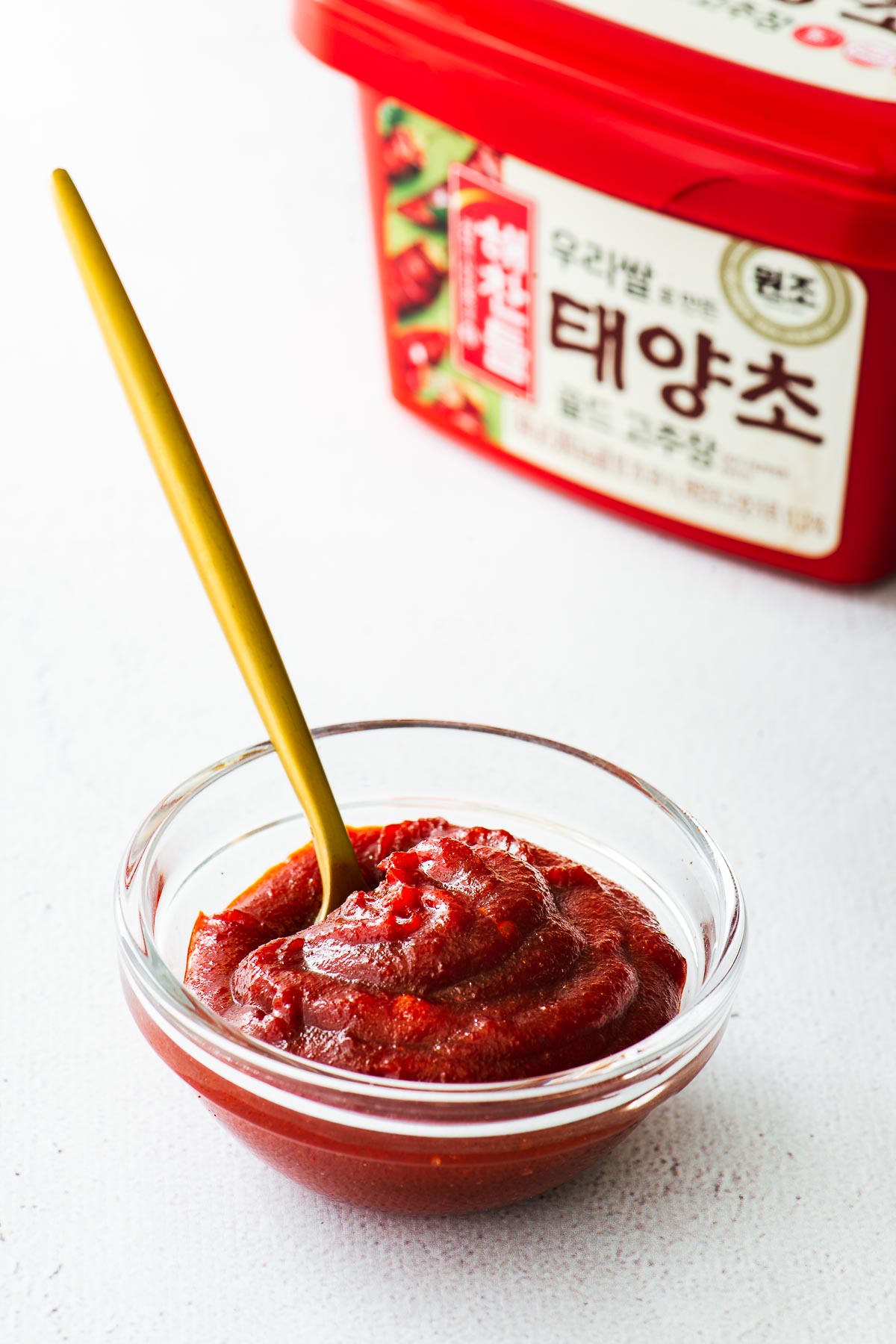
Gochujang questions
Is gochujang vegan?
Yes, gochujang is vegan. Traditional gochujang ingredients are red chilli powder, glutinous rice powder, barley malt powder, powdered fermented soybeans, and salt.
Is gochujang gluten-free?
No, most commercial gochujang is not gluten-free. Gochujang is a fermented chilli paste that can contain barley malt powder, whole wheat kernels or wheat flour.
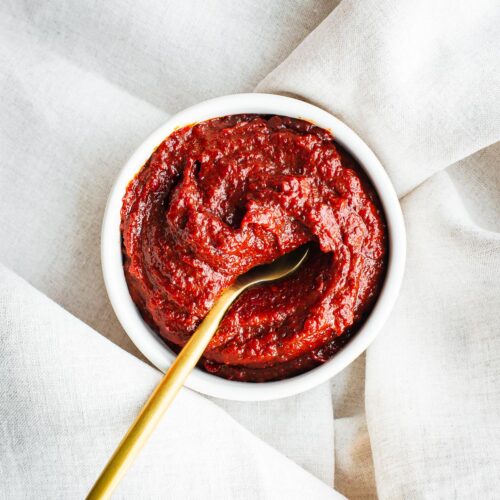
Equipment
- A small food processor, blender or immersion blender.
Ingredients
- ½ cup miso paste
- ½ cup gochugaru (Korean chilli powder)
- ¼ cup maple syrup
- 1 tablespoon soy sauce
- 1 teaspoon rice vinegar
- 1 teaspoon onion powder
Instructions
- Skip this step if you have a fine chilli powder. Otherwise, add the chilli powder to a blender or spice grinder and blitz until fine (or at least finer).
- Place all the ingredients in a small food processor or use an immersion blender to blend everything into a smooth paste.
- If your paste is too thick to blend, add water, one teaspoon at a time. I typically add about two tablespoons of water. You want a thick paste similar to the texture of tomato paste.
Notes
- For a milder gochujang paste, start with a ¼ cup chilli powder and add more until you reach your preferred spice level.
- If you don’t have gochugaru, see the best gochugaru substitute for gochujang (and more).
- See the section on ingredients for more detailed ingredient information and substitutes.
- Refrigerate leftover gochujang substitute in a clean airtight container.
Try these recipes with gochujang
- Gochujang tofu (spicy Korean braised tofu)
- Bibimbap sauce (Korean gochujang sauce)
- Gochujang tofu (spicy Korean braised tofu)
- Or try a delicious Korean broccoli side dish. Add a teaspoon of gochujang (or gochujang substitute) to this Korean sesame broccoli salad.
Or read more about my favourite ingredients in Asian cuisine:

Very Useful Info. Thank you.
Thank you so much for taking the time to review my post, June!
Hi, lovely recipe. Thanks so much.
Jus wanted to know though,
How long does the paste last?
Should i keep it in the fridge or not?
Hi Saajidah, thanks for pointing this oversight out!
Yes, you should refrigerate the paste in a clean airtight container.
I kept my paste in the fridge for over three months without any problem. Always use clean utensils when spooning it out to avoid contamination with bacteria.
Awesome! This is certainly worth a shot! The gochujang is of excellent quality. Thank you very much for sharing the recipe
Thank you so much for taking the time to leave a review, Karisha!
I’m so happy you like the gochujang mix. I looooove gochujang, and can’t imagine my kitchen without it!
Saved my life! Wanted to make Korean style lamb chops but i don’t have gochujang! Thank God i have doenjang hehe
So happy I could help you avoid a catastrophe! And those Korean-style lamb chops sound amazing…